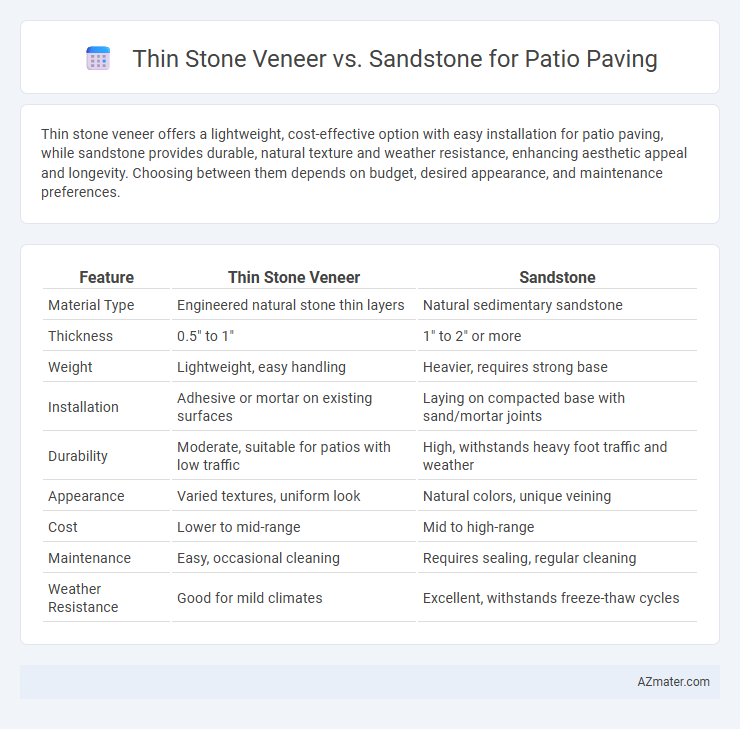Thin stone veneer offers a lightweight, cost-effective option with easy installation for patio paving, while sandstone provides durable, natural texture and weather resistance, enhancing aesthetic appeal and longevity. Choosing between them depends on budget, desired appearance, and maintenance preferences.
Table of Comparison
| Feature | Thin Stone Veneer | Sandstone |
|---|---|---|
| Material Type | Engineered natural stone thin layers | Natural sedimentary sandstone |
| Thickness | 0.5" to 1" | 1" to 2" or more |
| Weight | Lightweight, easy handling | Heavier, requires strong base |
| Installation | Adhesive or mortar on existing surfaces | Laying on compacted base with sand/mortar joints |
| Durability | Moderate, suitable for patios with low traffic | High, withstands heavy foot traffic and weather |
| Appearance | Varied textures, uniform look | Natural colors, unique veining |
| Cost | Lower to mid-range | Mid to high-range |
| Maintenance | Easy, occasional cleaning | Requires sealing, regular cleaning |
| Weather Resistance | Good for mild climates | Excellent, withstands freeze-thaw cycles |
Introduction: Choosing the Right Patio Paving Material
Thin stone veneer offers a lightweight, cost-effective solution with easy installation and a natural stone appearance, ideal for enhancing patio aesthetics without extensive groundwork. Sandstone provides durable, slip-resistant surface qualities and unique earthy tones, making it a popular choice for long-lasting outdoor paving applications. Evaluating factors such as budget, installation complexity, maintenance, and desired visual appeal helps determine the best material for patio paving projects.
Overview of Thin Stone Veneer
Thin stone veneer offers a lightweight, cost-effective alternative to traditional sandstone for patio paving, providing natural stone appearance with less material thickness. It is easier to install due to its reduced weight and flexibility in application, making it ideal for both vertical and horizontal surfaces. Unlike full-thickness sandstone, thin veneer requires less structural support while maintaining durability and aesthetic appeal.
Overview of Sandstone for Patio Paving
Sandstone is a popular choice for patio paving due to its natural durability, slip resistance, and varied color palette ranging from warm reds to soft tans, offering aesthetic versatility. Its porous nature allows for effective drainage, making it suitable for outdoor use but requiring periodic sealing to prevent staining and weathering. Compared to thin stone veneer, sandstone provides a thicker, more robust surface that enhances longevity and withstands heavy foot traffic.
Installation Process: Thin Stone Veneer vs Sandstone
Thin stone veneer offers a lightweight and easier installation process compared to traditional sandstone slabs, requiring less structural support and typically adhered with mortar or specialized adhesives. Sandstone paving involves heavier, thicker slabs that demand a properly prepared sub-base and precise leveling to ensure stability and durability. Both materials require sealing for protection, but thin stone veneer installation tends to be faster and less labor-intensive.
Durability and Longevity Comparison
Thin stone veneer offers a durable and cost-effective option for patio paving, providing a lightweight yet resilient surface that resists cracking and weathering over time. Sandstone, known for its natural strength and resistance to abrasion, offers exceptional longevity with proper sealing but can be more susceptible to erosion in harsh climates. Both materials balance durability with aesthetic appeal, though sandstone typically outlasts thin stone veneer in high-traffic or extreme weather conditions.
Aesthetic Appeal and Design Versatility
Thin stone veneer offers a sleek, contemporary aesthetic with a wide range of colors and textures, allowing for seamless integration into modern patio designs. Sandstone provides a natural, warm appeal with its earthy tones and unique grain patterns, ideal for rustic and classic outdoor spaces. Both materials deliver design versatility, but thin stone veneer's lightweight nature enables installation on various surfaces, expanding creative possibilities beyond traditional paving.
Maintenance Requirements for Each Material
Thin stone veneer requires minimal maintenance as it is less prone to cracking and does not require sealing, making it ideal for patios that experience varying weather conditions. Sandstone, while attractive, demands regular sealing and cleaning to prevent weathering, staining, and erosion due to its porous nature. Both materials benefit from periodic inspection to address any surface damage promptly, but thin stone veneer generally offers a more durable and low-maintenance option for patio paving.
Cost Analysis: Thin Stone Veneer vs Sandstone
Thin stone veneer typically costs less than natural sandstone for patio paving due to its thinner profile and lower material volume, resulting in reduced transportation and installation expenses. Sandstone, known for its durability and natural beauty, often commands a higher price per square foot, especially for high-quality or rare stone varieties. When considering long-term value, thin stone veneer offers a budget-friendly alternative, but sandstone may provide greater resilience and aesthetic appeal, potentially increasing property value over time.
Environmental Impact and Sustainability
Thin stone veneer offers a lower environmental impact than traditional sandstone patio paving due to reduced quarrying requirements and less material transportation weight. Sandstone, while durable and naturally abundant, often involves more extensive extraction processes that can disrupt ecosystems and increase carbon emissions. Choosing thin stone veneer promotes sustainability by minimizing resource use and enabling easier recycling or repurposing of patio materials.
Conclusion: Which Paving Material is Best for Your Patio?
Thin stone veneer offers a lightweight, cost-effective option with easy installation and a modern aesthetic, while sandstone provides superior durability, natural texture, and timeless appeal for high-traffic patio areas. Choosing between thin stone veneer and sandstone depends on factors such as budget, desired appearance, and long-term maintenance considerations. For a balance of strength and classic style, sandstone is ideal, whereas thin stone veneer suits projects prioritizing ease and affordability.

Infographic: Thin stone veneer vs Sandstone for Patio paving
 azmater.com
azmater.com